For many naturals, having healthy, full, and long hair is the ultimate goal. It’s quite sad that some hair types are associated with “not growing”, which is not the case. The truth is, all hair grows no matter the curl pattern, porosity, or even texture. Hair grows at least half an inch every month. The problem is retaining the length. Here are a few tips on how you can retain length and see significant growth with your hair.
Protect Your Hair When You Sleep
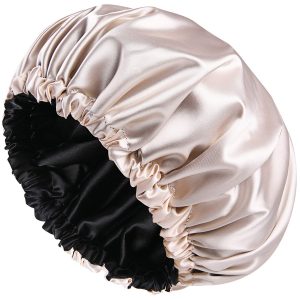
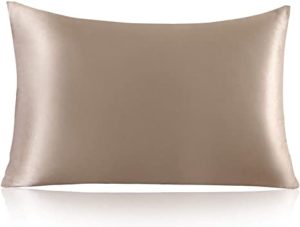
How does protecting your hair when you sleep help retain length? Well, cotton is a great fabric. It is soft and super absorbent. Absorption may be great but if it includes draining your hair, it may not be so great after all. This also affects your skincare products too (a story for another day).
When hair is dry, it becomes frizzy, tangled, is prone to split ends and breakage. These problems damage the hair, make it almost impossible to detangle it and in the process, you lose too much hair. The best way to avoid this is by investing in silk or satin bonnets, bedsheets, and pillowcases.
Silk is great because it is a natural material that does not suck out any moisture leaving your hair luscious and moisturized. Satin can contain silk, polyester, and nylon, and it provides similar benefits as silk. I have both a satin bonnet and pillowcases, and my hair and skin are doing so much better because of them.
When investing in a silk or satin bonnet, double-check that it is surrounded by that material, including the borders. If it’s adjustable, it shouldn’t be too tight or have rubber on the inside, so you don’t damage your hair and edges.
Use Protective Styles
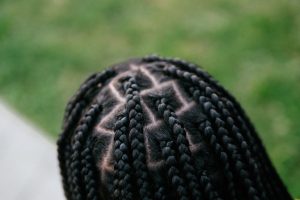
The power a protective style holds is unimaginable. A protective style is meant to keep your hair safely tucked away from the elements and the notorious ‘hand-in-hair syndrome.’ Constant manipulation dries hair out, promotes shedding and unnecessary breakage. This stunts your hair growth or simply eradicates any signs of new growth.
For a protective style to be effective, make sure that it is low in manipulation, lasts at least a week or longer, preferably multiple weeks, and isn’t so tight that moving your neck is a problem. Keep in mind that you should also give yourself breaks in between styles and rotate them as often as you can. Why? Because your hair will need extra moisture and TLC if the style was left in for a long time. Also, remember that if you keep parting the hair in the same way, it is bound to thin out in those same areas. The same result applies if the style is too tight.
I tried various braided updos during the summer of the pandemic in 2020 and I didn’t realize it at the time, but my edges were starting to thin drastically. By the time I caught it, my baby hairs were nearly gone, and the front of my hairline was extremely thin. I managed to salvage my hair and retain length by moisturizing and oiling those parts constantly and by wearing my natural hair out for a while.
Trim Your Ends
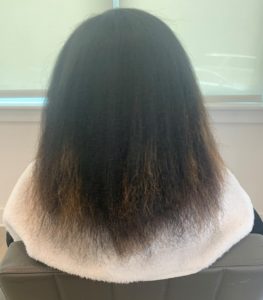
There is a false narrative that afro-textured hair doesn’t need regular trims. Let’s just say, this is a LIE. No matter your hair type, trimming is a MUST. Your ends are the oldest part of your hair. This means they’ve simply seen and been through it all. Split ends will continuously split up your hair shaft thus destroying your strands.
When you get them, there is no cure, no magic elixir or special oil you can apply to fix them. Also, just because you have them, doesn’t mean that you’re not taking care of your hair either. Remember, split ends don’t always occur because of carelessness, it could just be that your ends are old and need a trim.
The picture above is of me visiting a salon for the first time in over 6 months and my ends were terrible. I was using regular scissors to trim my hair and accidentally cut out some chunks when I took out my braids.
Try to see a professional hairdresser to trim those ends at least 3-4 times a year to keep your hair in check. If you’re unable to see a professional, you can do it yourself by using a pair of hair-cutting scissors. These can be found at your local supermarket, beauty supply, or online. Now, the evenness of your hair may not be the same as if you were to see a professional. This can be avoided if you have multiple mirrors, steady hands, and patience, or someone you trust to help.
Moisturize Correctly

So, how do you moisturize? For some, that means only using moisturizing oils like coconut oil or a combination of oils. The idea of using as many oils as possible may not be practical as you were led to believe. Depending on what your porosity is, either the L.C.O or L.O.C method is better for moisturizing.
This means you start with a Liquid or leave-in (conditioner), then an Oil, then Cream, or vice versa. Moisturized hair is less likely to break and is less prone to split ends or damage, making it easy for you to retain all the length you have been able to accumulate. Applying oils on dry hair does nothing for it because oils and creams are generally meant to seal in moisture. Now, not everyone needs to follow this method.
Those who are experts with their hair may not need as many steps or might need even more, but this is a good guideline to follow for those who are new to the natural hair community or still need help. I know my hair is temperamental and would need extra steps sometimes, but most of the time the L.C.O method worked best.
Don’t Forget Your Scalp
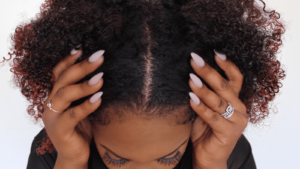
A lot of the time, we prioritize the hair and discredit the scalp. Keep in mind that product build-up obstructs any kind of growth because your pores are clogged. Hair comes from the scalp and if it’s unhealthy, you cannot expect to grow healthy hair. For this reason, actively taking care of the scalp should be just as important as the rest of your hair.
Sebum is a waxy oil secreted by the scalp and responsible for all the natural oils found in hair. So, when the scalp is not in the best form, the secretion of these oils and nutrients is not possible. This makes the hair dry, frizzy, tangled, and dull. Let’s discuss a way to properly take care of the scalp.
Start with how you wash your hair. Try not to use your fingernails or at least don’t scratch too hard to lift any dirt or build-up from your scalp. I know this is easier said than done, I still do it sometimes myself. The last thing you want is deep cuts on your scalp. If there’s a lot of build-up on your scalp, try using a clarifying shampoo and let it sit for a few minutes so you feel that tingling sensation. This is a better alternative to aggressively scratching your scalp and your hair will notice the difference.
Takeaway
Don’t believe that growing out your hair and retaining the length is impossible. Hair will grow even if you don’t put any effort into it. What’s important, is to know that when your hair is healthy and maintained, growth and retention are inevitable.
